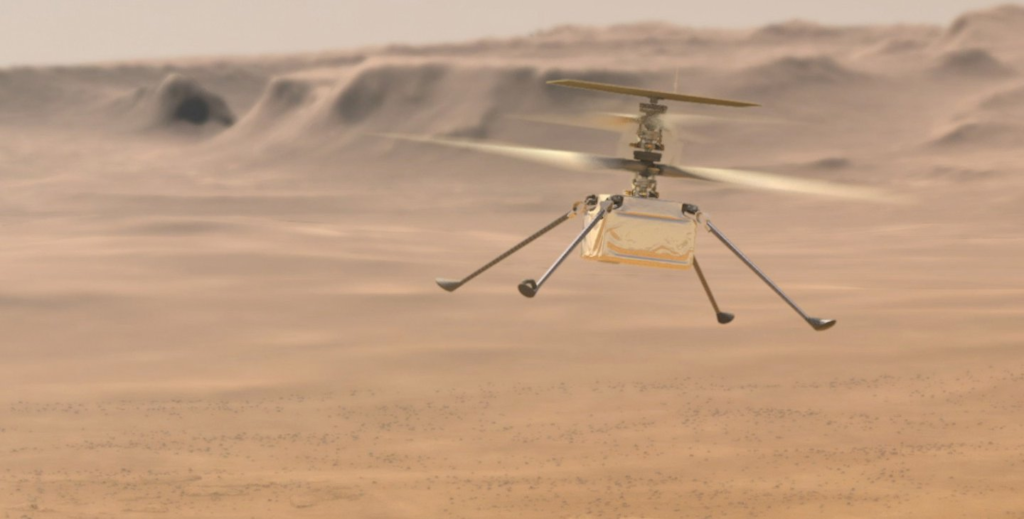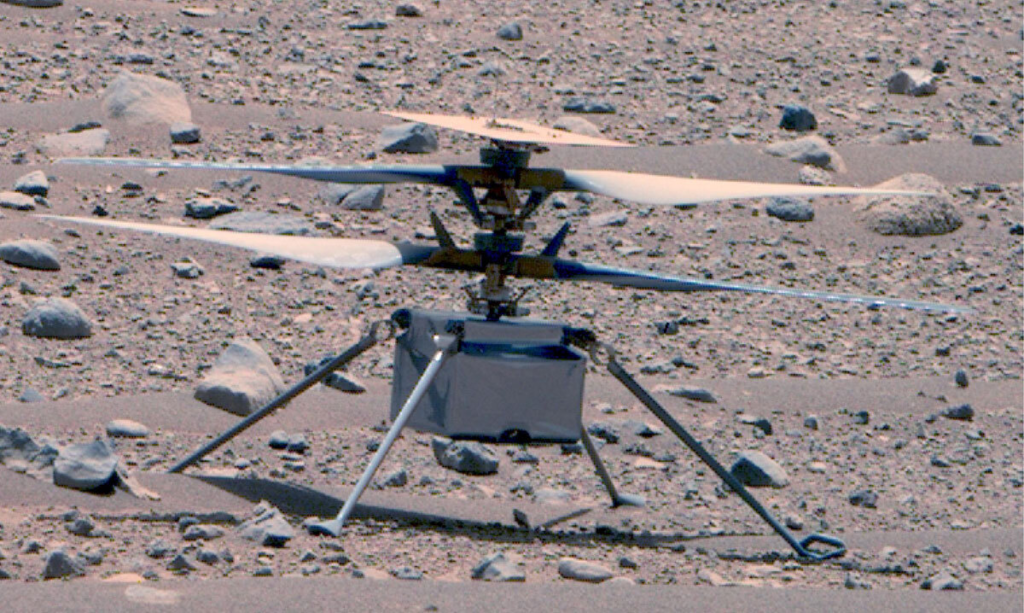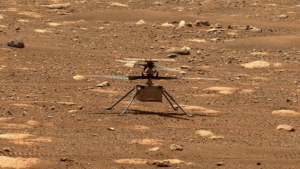
NASA Just Regained Contact With Ingenuity
Ever since the Perseverance Rover landed on the Martian surface more than two years ago, Ingenuity has been consistently flying. Despite a mission goal around one month long, the helicopter surpassed these expectations and has been continuing to help gather new information and scout for the rover. This was up until a few months ago when NASA lost contact with it.
Specifically, Ingenuity attempted its 52nd flight back on April 26th and while NASA knew the helicopter had flown as instructed, they lost contact with it as it descended. Since then, the agency hadn’t heard a thing and wasn’t sure about the condition of the helicopter. We now know that Ingenuity is in good health and will attempt another flight soon.
This is good news as Perseverance could benefit heavily from more scouting as it makes its way toward new terrain. Here I will go more in-depth into what caused the two month long communication blackout, some of the issues the helicopter has run into, what to expect in the coming months, and more.
Regained Contact

In a new report from NASA the agency was quoted saying, “The Ingenuity team expected the communications dropout because a hill stood between the helicopter’s landing location and the Perseverance rover’s position, blocking communication between the two.” In this case, the rover acts as a radio relay between the helicopter and mission controllers at JPL. In anticipation of this loss of communications, the Ingenuity team had already developed re-contact plans for when the rover would drive back within range. Contact was re-established June 28 when Perseverance crested the hill and could see Ingenuity again.
The goal of Flight 52, a 1,191-foot (363-meter) and 139-second-long flight, (which was the last one before the blackout) was to reposition the helicopter and take images of the Martian surface for the rover’s science team. Above, NASA’s Ingenuity Mars Helicopter was captured by the Perseverance rover’s Mastcam-Z on April 16, not long after the rotorcraft’s 50th flight. This was one of the last images before the helicopter would soon fall silent for 63 days. You can see that with the exception of dust, Ingenuity is intact and looks good.
Focusing back on the communication blackout, JPL’s Josh Anderson, the Ingenuity team lead commented, “The portion of Jezero Crater the rover and helicopter are currently exploring has a lot of rugged terrain, which makes communications dropouts more likely. The team’s goal is to keep Ingenuity ahead of Perseverance, which occasionally involves temporarily pushing beyond communication limits. We’re excited to be back in communications range with Ingenuity and receive confirmation of Flight 52.”
Sixty-three days is a long time to wait for the results of a flight, but the data coming in indicates all is well with the first aircraft on another world. With all this in mind, it seems like the teams at JPL and NASA are taking some necessary risks with Ingenuity and the terrain is somewhat forcing their hand. Because of the communication limitation between Perseverance and Ingenuity, we can likely expect even more communication blackouts in the next few months. This all depends on the terrain and whether or not it clears up.
Ingenuity and Perseverance landed inside Jezero in February 2021. The chopper quickly aced its primary mission, a five-flight campaign designed to show that aerial exploration is feasible on Mars. Ingenuity then embarked on an extended mission, during which it’s serving as a scout for Perseverance. While both the rover and helicopter began their mission inside the Jezero crater, they have since moved toward more hilly terrain.
While the loss of communication for over two months is not ideal, the agency has run into a few other problems in the past. Back around Sol 685 for example, the helicopter had unfortunately been drifting in and out of nighttime survival mode (having enough power to avoid overnight brownouts). These overnight brownouts lead to uncertainty in Ingenuity’s wakeup time, which makes planning much harder. Even just months ago they reported that despite the imminent return of Martian summer, dust on the solar panel would cause Ingenuity to remain in a transitional power state for some time.
In terms of the future, if the remainder of Ingenuity’s health checks provides promising results, the helicopter may fly again within the next couple of weeks. The target for Flight 53 is an interim airfield to the west, from which the team plans to perform another westward flight to a new base of operations near a rocky outcrop the Perseverance team is interested in exploring.
Ingenuity’s Value

Assuming the rest of the health checks are good, Ingenuity will be extremely busy. Right now, Perseverance is on the hunt for a conglomerate rock to sample for return to Earth – a task that is proving to be challenging. Two attempts were made to core, but the soft rock crumbled during each attempt. The team set sights on a neighboring outcrop called Stone Man Pass, about 40 meters away, to search for a less crumbly conglomerate that could stand up to the coring process. After nearing Stone Man Pass, rover cameras indicated the rock is not a conglomerate, so instead, Perseverance drove to Emerald Lake, an outcrop a few tens of meters away and within the same layer as Onahu, to attempt sampling here.
If Ingenuity could get in the air and continue to scout, the Perseverance team would have a great opportunity to look at a bunch of options for future sample locations. Originally, the Perseverance rover spent the first two Earth years of its mission on Mars driving and sampling within Jezero crater. As anticipated, Jezero was found to be rich with interesting geological features, and the rover used 21 of its precious 43 sample tubes in the region. The rover wrapped up this science campaign by dropping 10 of these samples in a backup depot area for retrieval by a future mission. With this important work out of the way, the rover’s science team eagerly turned its attention to the prospect of new and exciting discoveries in the unexplored area on the Delta Top. To reach these areas as quickly as possible, the scientists planned an aggressive driving campaign up the river delta.
At the time, this fresh terrain represented a golden opportunity for Ingenuity to prove its worth to the rover’s science mission. Providing the rover team with recon images just a few days before the rover reaches a site gives scientists significantly more time to determine their exploration priorities, and gives rover planners advanced notice of any unexpected terrain. With the fading of Martian winter, Ingenuity now had enough power to fly hundreds of meters ahead of the rover with each flight and deliver on the promise of being a real science scout.
The race up the delta began cautiously at first, with a scouting flight over rocky top on Sol 689 (Flight 41). This was needed because one of the most critical things that Ingenuity (and to a lesser extent Perseverance) needs for planning is a good understanding of the terrain. This understanding comes primarily from expert planetary geologists who correlate satellite imagery with the terrain observed on the ground. There was some concern that the terrain in the river delta was so unlike that seen in the flat crater floor, that it might invalidate these correlation models. After imagery from Flight 41 showed that they could still trust their terrain understanding to find landing sites, they had everything they needed to start flying.
This game of cat and mouse repeated itself several more times over the next few flights, with the helicopter operations team eventually setting a new record for flight frequency. While the helicopter team typically hopes to fly as often as once a week, they ultimately completed four flights (42-46) in the space of just nine days. As promised, the team also started pushing the flight envelope of the rotorcraft. Starting with Flight 43, they changed the standard flight altitude from 10 meters to 12 meters in preparation for higher flight speeds. They then proceeded to set a new flight speed record of 6 meters per second during Flight 45.
Taken together, these incredible efforts allowed the helicopter to stay ahead of the rover all the way up the delta, arriving at its destination (within sight of Tenby) while holding a respectable two-sol lead on Perseverance. A number of issues including communications failures, anomalies with the rover, and a recurrence of a known helicopter camera issue prevented the teams from getting advanced reconnaissance of Tenby, but this highlights the importance of this helicopter and what it can do when operating as intended.
Ingenuity has completed 52 flights since first taking to the skies above the Red Planet on April 19, 2021, far exceeding its originally planned technology demonstration of up to five flights. Some of the helicopter highlights so far include the first aircraft to achieve powered, controlled flight on another planet, successfully flying in the extremely thin Martian atmosphere, paving the way for future aerial explorers at Mars and, potentially, other space destinations, and completing 91.4 flying minutes, covering 7.3 miles (11.7 km), and reaching altitudes as high as 59.1 ft (18.0 m).
Conclusion
NASA was just able to regain contact with Ingenuity after more than two months of radio silence. The reason had to do with rough terrain that blocked the communication link between the rover and the helicopter. We will have to wait and see how it progresses and the impact it has on the space industry.



